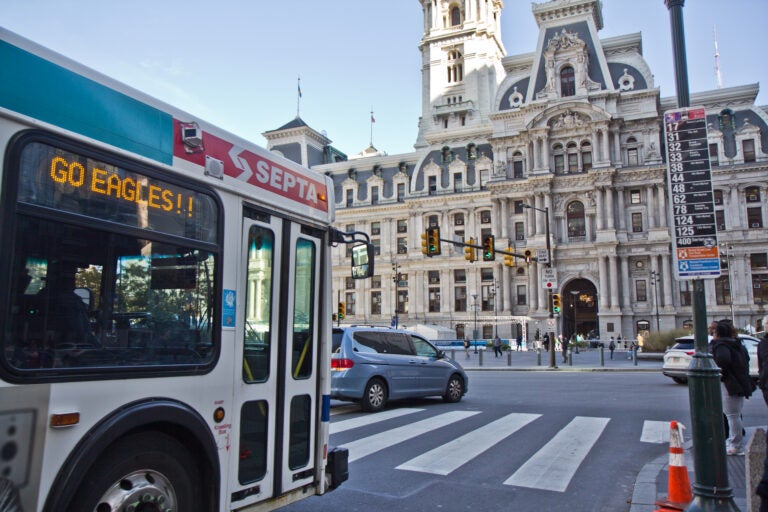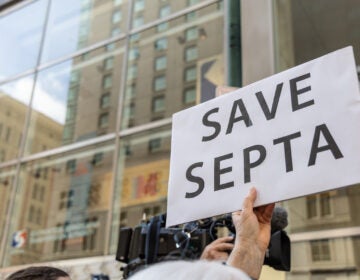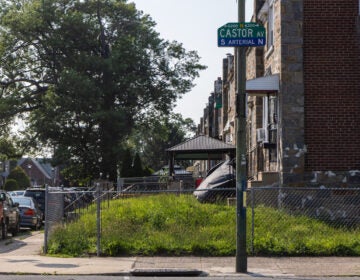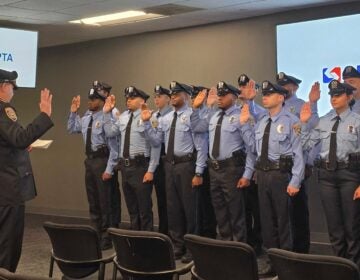Philly officials support automated bus lane enforcement and say it could improve ‘transit equity’
State Rep. Martina White plans a bill that would create two pilot programs using a system in which cameras record and ticket drivers who park in bus lanes.

A SEPTA bus approaches City Hall in a bus lane. (Kimberly Paynter/WHYY)
Republican State Rep. Martina White plans to introduce legislation for automated bus lane enforcement in Philadelphia.
White, who chairs the State House public transportation subcommittee, issued a memo with her plan and calling for cooperation from her colleagues earlier this month.
The legislation would create two pilot programs that would allow the use of an automated bus lane enforcement system in which cameras record and ticket drivers who park in bus lanes.
According to the memo, SEPTA would run the program, which is designed to “promote traffic safety and accessibility and reduce congestion.” If enacted into law, the measure would also allow SEPTA to be compensated for running the program. Money from the program would go toward small-business grants in the city.
White could not immediately be reached for comment, but officials from the city’s Office of Transportation, Infrastructure, and Sustainability (oTIS) are on board with the plan, though it would require City Council approval once it passed in the state legislature. Transportation officials are eyeing Chestnut and Market Streets and Roosevelt Boulevard in the future as places for the enforcement.
The city recently launched an automated camera enforcement program on Roosevelt Boulevard using speed cameras at select intersections to improve safety.
City transportation officials say such a program for bus lanes can help improve transit equity.
“Automated enforcement reduces the interaction of police and communities while also assuring that people who ride buses, including people of color and low-income customers, have better access to jobs and other destinations,” said Michael Carroll, oTIS deputy managing director and a SEPTA board member.
Recently, the city launched a pilot program that provided designated loading zones on Chestnut Street to increase bus speeds and reduce traffic congestion.
The city released a report on its findings from the pilot and found median midday travel times dropped by 19% between 22nd and Broad streets, and illegal parking and loading that blocked lanes was reduced. Still, city officials suggest automated camera enforcement “will improve bus service on Chestnut Street by providing consistent enforcement when needed most — when a vehicle is blocking the bus.”
“We see buses stuck in traffic, and when we try to make it better, like on Chestnut and Market … there’s some engineering things we can’t do,” said Chris Puchalsky, director of policy and strategic initiatives for oTIS.
SEPTA and the city also conducted two enforcement blitz programs between 2018 and 2019. Andrew Busch, spokesperson for the transportation authority, could not provide numbers for the second, but the first iteration of the blitz improved bus travel times by 6% on Chestnut Street river to river during midday hours.

Subscribe to PlanPhilly
Busch said the enforcement would continue improvements and complement the authority’s upcoming comprehensive bus network redesign. Officials are currently evaluating proposals for a three-year contract to redesign the bus system.
“We certainly think it’s something that, moving forward, would benefit SEPTA and our riders looking to get through some congested areas in Center City in a more efficient way,” Busch said.
New York City’s Metropolitan Transportation Authority implemented bus-mounted cameras on 123 buses across three routes. Last October, transportation officials kicked off the program on the M15 bus route, which runs on First and Second avenues in Manhattan.
The MTA reported two months later that bus travel times increased up to 34% on some segments. Wait times also improved, with about 77% of buses showing up within three minutes of their scheduled times during peak hours and five minutes during non-peak.
Fines, issued after a 60-day warning period, range from $50 to $250 within a 12-month period.
The MTA’s system uses both pole-mounted and bus-mounted cameras, a system Puchalsky said would be ideal for a robust system. But Busch said there is no determination yet what SEPTA will use.
WHYY is your source for fact-based, in-depth journalism and information. As a nonprofit organization, we rely on financial support from readers like you. Please give today.








